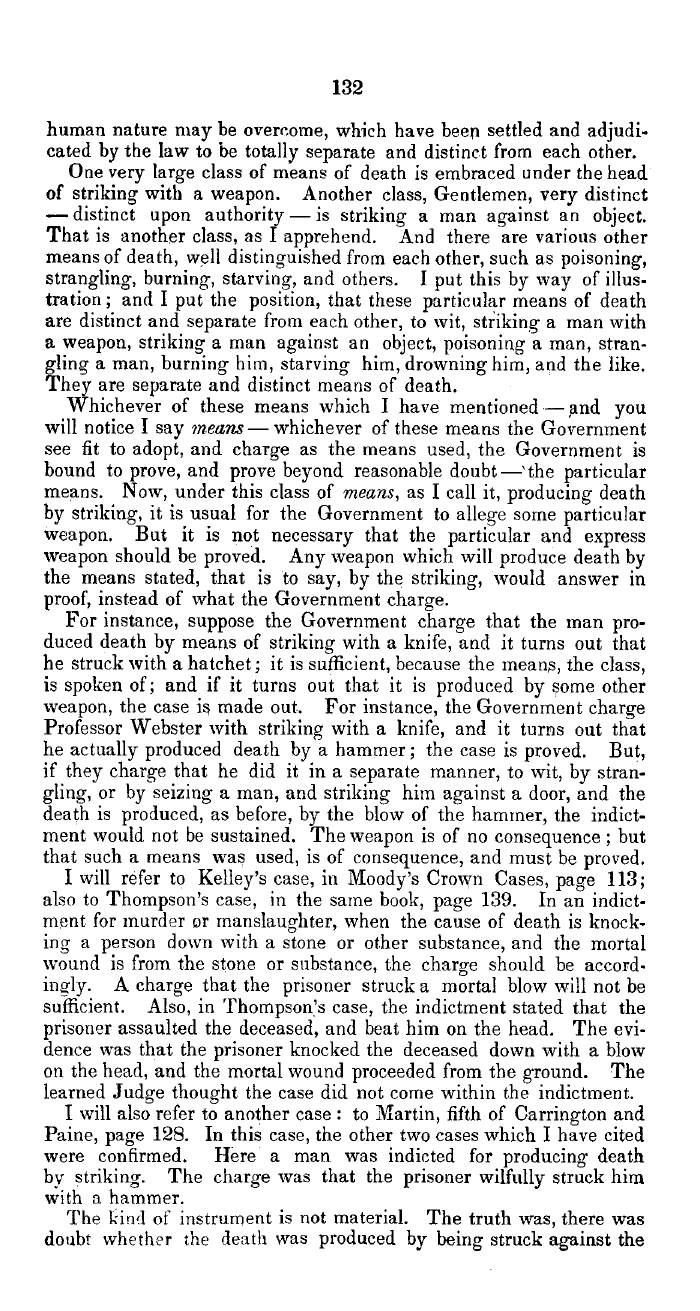|
132
human nature may be overcome, which have beep settled and adjudi.
cated by the law to be totally separate and distinct from each other.
One very large class of means of death is embraced under the head
of striking with a weapon. Another class, Gentlemen, very distinct
-distinct upon authority - is striking a man against an object.
That is another class, as I apprehend. And there are various other
means of death, well distinguished from each other, such as poisoning,
strangling, burning, starving, and others. I put this byway of illus-
tration; and I put the position, that these particular means of death
are distinct and separate from each other, to wit, striking a man with
a weapon, striking a man against an object, poisoning a man, stran-
gling a man, burning him, starving him, drowning him, and the like.
They are separate and distinct means of death.
Whichever of these means which I have mentioned - and you
will notice I say means-whichever of these means the Government
see fit to adopt, and charge as the means used, the Government is
bound to prove, and prove beyond reasonable doubt =the particular
means. Now, under this class of means, as I call it, producing death
by striking it is usual for the Government to allege some particular
weapon. But it is not necessary that the particular and express
weapon should be proved. Any weapon which will produce death by
the means stated, that is to say, by the striking, would answer in
proof, instead of what the Government charge.
For instance, suppose the Government charge that the man pro-
duced death by means of striking with a knife, and it turns out that
he struck with a hatchet; it is sufficient, because the mean, the class,
is spoken of; and if it turns out that it is produced by some other
weapon, the case is made out. For instance, the Government charge
Professor Webster with striking with a knife, and it turns out that
he actually produced death by a hammer; the case is proved. But,
if they charge that he did it in a separate manner, to wit, by stran-
gling, or by seizing a man, and striking him against a door, and the
death is produced, as before, by the blow of the hammer, the indict-
ment would not be sustained. The weapon is of no consequence; but
that such a means was used, is of consequence, and must be proved.
I will refer to Kelley's case, in Moody's Crown Cases, page 113;
also to Thompson's case, in the same book, page 139. In an indict-
ment for murder or manslaughter, when the cause of death is knock-
ing a person down with a stone or other substance, and the mortal
wound is from the stone or substance, the charge should be accord-
ingly. A charge that the prisoner struck a mortal blow will not be
sufficient. Also, in Thompson's case, the indictment stated that the
prisoner assaulted the deceased, and beat him on the head. The evi-
dence was that the prisoner knocked the deceased down with a blow
on the head, and the mortal wound proceeded from the ground. The
learned Judge thought the case did not come within the indictment.
I will also refer to another case : to Martin, fifth of Carrington and
Paine, page 128. In this case, the other two cases which I have cited
were confirmed. Here a man was indicted for producing death
by striking. The charge was that the prisoner wilfully struck him
with a hammer.
The kind of instrument is not material. The truth was, there was
doubt whether the death was produced by being struck against the
|

